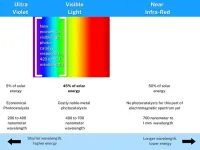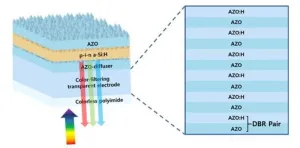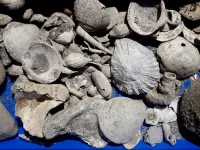(Press-News.org) New research finds that sleep can be most efficient and restful for older adults when nighttime bedroom ambient temperature ranges between 68 to 77 °F.
The authors observed an overall trend: a 5-10 % drop in sleep efficiency as the nighttime ambient temperature increases from 77°F to 86°F. Importantly, this research also reveals substantial between-individual differences in optimal bedroom temperature.
“These results highlight the potential to enhance sleep quality in older adults by optimizing home thermal environments and emphasizing the importance of personalized temperature adjustments based on individual needs and circumstances,” said lead researcher Amir Baniassadi, PhD, Hinda and Arthur Marcus Institute for Aging Research at Hebrew SeniorLife, and Harvard Medical School.
“Additionally, the study underscores the potential impact of climate change on sleep quality in older adults, particularly those with lower socioeconomic status, and supports increasing their adaptive capacity as nighttime temperatures increase in cities across the country,” Baniassadi said.
This longitudinal observational study examines the association between bedroom nighttime temperature and sleep quality in a sample of community dwelling older adults. Using wearable sleep monitors and environmental sensors, researchers monitored sleep duration, efficiency, and restlessness over an extended period within participants' homes while controlling for potential confounders and covariates. The study collected nearly 11,000 person-nights of sleep and environmental data from 50 older adults. The associations were primarily nonlinear, and substantial between-subject variations were observed.
The findings were published in the article, Nighttime ambient temperature and sleep in community-dwelling older adults, appearing in Science of The Total Environment. Authors were Amir Baniassadi; Brad Manor, PhD, Hinda and Arthur Marcus Institute for Aging Research at Hebrew SeniorLife, and Harvard Medical School; Wanting Yu, ME, Hinda and Arthur Marcus Institute for Aging Research at Hebrew SeniorLife; Thomas Travison, PhD, Hinda and Arthur Marcus Institute for Aging Research at Hebrew SeniorLife, and Harvard Medical School; and Lewis Lipsitz, MD, Hinda and Arthur Marcus Institute for Aging Research at Hebrew SeniorLife, and Harvard Medical School.
Older adults often experience inadequate, restless, and disrupted sleep which in turn influences many outcomes related to their health and wellbeing such as cognitive and physical function, mood and affect, irritability and reaction to stress, productivity, diabetes management, and risk of cardiovascular diseases. Indeed, poor sleep is disproportionately more common among older adults. Meanwhile, research on its causes has been mostly focused on physiological and behavioral factors despite evidence suggesting that the environment the person sleeps in can be as influential.
As a result, while numerous medical and behavioral interventions have been developed to improve outcomes related to sleep, the potential of environmental interventions have been largely overlooked. Within this context, the link between home ambient temperature and sleep within older adults can be a potential target for improving sleep, which motivated the researchers to conduct this study. The authors plan to continue this line of work by focusing on the potential impact of climate change on sleep in low-income older adults and developing interventions to optimize their environment.
This study was supported by TMCITY foundation. Additionally, Baniassadi acknowledges support by a T32 fellowship through U.S. National Institute on Aging (T32AG023480).
about this subject in this blog post by Dr. Baniassadi: Sleep and Rising Temperatures: The Hidden Impact of Climate Change on Older Adults.
About Hebrew SeniorLife
Hebrew SeniorLife, an affiliate of Harvard Medical School, is a national senior services leader uniquely dedicated to rethinking, researching, and redefining the possibilities of aging. Hebrew SeniorLife cares for more than 4,500 seniors a day across six campuses throughout Greater Boston. Locations include: Hebrew Rehabilitation Center-Boston and Hebrew Rehabilitation Center-NewBridge in Dedham; NewBridge on the Charles, Dedham; Orchard Cove, Canton; Simon C. Fireman Community, Randolph; Center Communities of Brookline, Brookline; and Jack Satter House, Revere. Founded in 1903, Hebrew SeniorLife also conducts influential research into aging at the Hinda and Arthur Marcus Institute for Aging Research, which has a portfolio of more than $85 million, making it one of the largest gerontological research facilities in the U.S. in a clinical setting. It also trains more than 1,000 geriatric care providers each year. For more information about Hebrew SeniorLife, visit our website or follow us on our blog, Facebook, Instagram, Twitter, and LinkedIn.
About the Hinda and Arthur Marcus Institute for Aging Research
Scientists at the Marcus Institute seek to transform the human experience of aging by conducting research that will ensure a life of health, dignity, and productivity into advanced age. The Marcus Institute carries out rigorous studies that discover the mechanisms of age-related disease and disability; lead to the prevention, treatment, and cure of disease; advance the standard of care for older people; and inform public decision-making.
END
Sleep can be most restful for older adults when nighttime temperature range is between 68 to 77 °F, study finds
Nighttime ambient temperature plays a pivotal role in sleep quality for older adults; study underscores potential impact of climate change on sleep quality in the aging population
2023-08-28
ELSE PRESS RELEASES FROM THIS DATE:
New study reveals anti-cancer properties in Kencur ginger
2023-08-28
You may know it as an aromatic spice to add flavor to your dishes or as a soothing herbal remedy to use for upset stomachs, but researchers from Osaka Metropolitan University have uncovered promising findings that Kencur, a tropical plant in the ginger family native to Southeast Asia, possesses anti-cancer effects.
Led by Associate Professor Akiko Kojima of the Graduate School of Human Life and Ecology, the researchers demonstrated that Kencur extract and its main active component, ethyl p-methoxycinnamate (EMC), significantly suppressed cancer cell growth at the cellular and animal levels.
While previous studies on EMC indicated its anti-cancer potential by decreasing the expression ...
New type of visible-light responsive photocatalyst is efficient, stable and very economical
2023-08-28
A new type of versatile economical photocatalyst that harnesses the visible portion of the sunlight spectrum has been developed by researchers from the University of Johannesburg. It is simple to manufacture.
Currently, economical photocatalysts only ‘use’ the UV spectrum of sunlight.
The new photocatalyst harnesses about a third of the visible light spectrum.
The extremely stable, powder-form three-component photocatalyst is built from graphitic carbon (89% of mass), a modified calixarene (10%) and a niobium-containing MXene (1%).
Researchers at the University of Johannesburg have developed a new type of photocatalyst that harnesses the visible ...
Low cost, high efficiency, multiple colors at the same time!
2023-08-28
A research team led by Dr. Jung-dae Kwon from the Department of Energy & Electronic Materials at the Korea Institute of Materials Science(KIMS) has succeeded in realizing the world's first transparent thin-film solar cell on a flexible substrate that exhibits different reflective colours and does not significantly reduce solar cell's efficiency. KIMS is a government-funded research institute under the Ministry of Science and ICT.
This is a technology that achieves reflective colour only a single material by periodically incorporating hydrogen into zinc oxide material doped with aluminium, which is a transparent electrode, to induce a refractive index difference. ...
New guidance on take-home naloxone for community overdose responders
2023-08-28
New guidance aimed at helping standardize community overdose response and take-home naloxone kits across Canada is published in CMAJ (Canadian Medical Association Journal) https://www.cmaj.ca/lookup/doi/10.1503/cmaj.230128. The guidance is an important document to optimize the effectiveness of take-home naloxone to save lives.
The guidance was developed by a panel of experts, including people with lived experience of drug use and overdose response, front-line and harm-reduction workers, public health professionals, clinicians and academics with expertise in harm reduction across Canada. ...
Indigenous females face disparities in health care in Canada
2023-08-28
Indigenous females living "off reserve" face many disparities in health care access, use and unmet needs, found new research in CMAJ (Canadian Medical Association Journal) https://www.cmaj.ca/lookup/doi/10.1503/cmaj.221407.
The study included 2902 First Nations, 2345 Métis, 742 Inuit and 74 760 non-Indigenous females of reproductive age (aged 15–55 years) obtained from the Canadian Community Health Survey from 2015 to 2020, including 4 months during the COVID-19 pandemic.
"We found that ...
Researcher finds inspiration from spider webs and beetles to harvest fresh water from thin air
2023-08-28
A team of researchers is designing novel systems to capture water vapour in the air and turn it into liquid.
University of Waterloo professor Michael Tam and his PhD students Yi Wang and Weinan Zhao have developed sponges or membranes with a large surface area that continually capture moisture from their surrounding environment.
Traditionally, fresh water for consumption is collected from rivers, lakes, groundwater, and oceans (with treatment). The current technologies Dr. Tam is developing are inspired by nature to harvest water from alternative sources as the world is facing ...
UEA researchers develop new tool to reduce stroke risk
2023-08-28
Peer reviewed – observational study - humans
Researchers at the University of East Anglia have developed a new way of identifying patients at risk of an irregular heartbeat, known as ‘atrial fibrillation’.
While not life threatening, the condition increases people’s risk of having a transient ischaemic attack (TIA) or stroke by up to five times.
A new study, published today, reveals four specific factors that can predict which patients will have atrial fibrillation.
These include older age, higher diastolic blood pressure and problems with both the coordination ...
No evidence grammar school systems are best for the brightest, study of 500,000 pupils reveals
2023-08-28
The UK’s brightest pupils’ chances of getting top GCSE grades are actually lower in grammar schools than in comprehensives, according to a major new piece of research.
The study, which was based on test results and other information from all pupils in England, challenges the common belief that high achievers do better in more academic schools.
Findings, published in the peer-reviewed journal Educational Review, demonstrate those with the highest scores at age 11 were less likely to achieve ...
Auckland wastewater pipe dig reveals 'fossil treasure trove'
2023-08-27
A new New Zealand Journal of Geology and Geophysics paper out today describes the 266 fossil species as one of the richest and most diverse groups of three-million-year-old fauna ever found in New Zealand. At least ten previously unknown species will be described and named in future research.
Fossil treasure trove from Auckland’s Mangere Wastewater Treatment Plant
In 2020, when Auckland’s Watercare were excavating two huge vertical shafts for a major upgrade of the major pipeline that brings raw sewage for treatment from the central city they dug through an ancient shell bed. Auckland paleontologist Bruce Hayward likened ...
Study: Individuals feel sex-specific symptoms before impending cardiac arrest
2023-08-27
Investigators from the Smidt Heart Institute at Cedars-Sinai are one step closer to helping individuals catch a sudden cardiac arrest before it happens, thanks to a study published today in the peer-reviewed journal Lancet Digital Health.
The study, led by sudden cardiac arrest expert Sumeet Chugh, MD, found that 50% of individuals who experienced a sudden cardiac arrest also experienced a telling symptom 24 hours before their loss of heart function.
Smidt Heart Institute investigators also learned that this warning symptom was different for women than it was for men. For women, the most prominent symptom of an impending sudden cardiac ...
LAST 30 PRESS RELEASES:
Duke and Duke-NUS’ joint cross-population research to uncover "East-West" differences in disease and care
Scientists to ‘spy’ on cancer- immune cell interactions using quantum technology breakthrough
Tech savvy users have most digital concerns
Making lighter work of calculating fluid and heat flow
Normalizing blood sugar can halve heart attack risk
Lowering blood sugar cuts heart attack risk in people with prediabetes
Study links genetic variants to risk of blinding eye disease in premature infants
Non-opioid ‘pain sponge’ therapy halts cartilage degeneration and relieves chronic pain
AI can pick up cultural values by mimicking how kids learn
China’s ecological redlines offer fast track to 30 x 30 global conservation goal
Invisible indoor threats: emerging household contaminants and their growing risks to human health
Adding antibody treatment to chemo boosts outcomes for children with rare cancer
Germline pathogenic variants among women without a history of breast cancer
Tanning beds triple melanoma risk, potentially causing broad DNA damage
Unique bond identified as key to viral infection speed
Indoor tanning makes youthful skin much older on a genetic level
Mouse model sheds new light on the causes and potential solutions to human GI problems linked to muscular dystrophy
The Journal of Nuclear Medicine ahead-of-print tip sheet: December 12, 2025
Smarter tools for peering into the microscopic world
Applications open for funding to conduct research in the Kinsey Institute archives
Global measure underestimates the severity of food insecurity
Child survivors of critical illness are missing out on timely follow up care
Risk-based vs annual breast cancer screening / the WISDOM randomized clinical trial
University of Toronto launches Electric Vehicle Innovation Ontario to accelerate advanced EV technologies and build Canada’s innovation advantage
Early relapse predicts poor outcomes in aggressive blood cancer
American College of Lifestyle Medicine applauds two CMS models aligned with lifestyle medicine practice and reimbursement
Clinical trial finds cannabis use not a barrier to quitting nicotine vaping
Supplemental nutrition assistance program policies and food insecurity
Switching immune cells to “night mode” could limit damage after a heart attack, study suggests
URI-based Global RIghts Project report spotlights continued troubling trends in worldwide inhumane treatment
[Press-News.org] Sleep can be most restful for older adults when nighttime temperature range is between 68 to 77 °F, study findsNighttime ambient temperature plays a pivotal role in sleep quality for older adults; study underscores potential impact of climate change on sleep quality in the aging population





